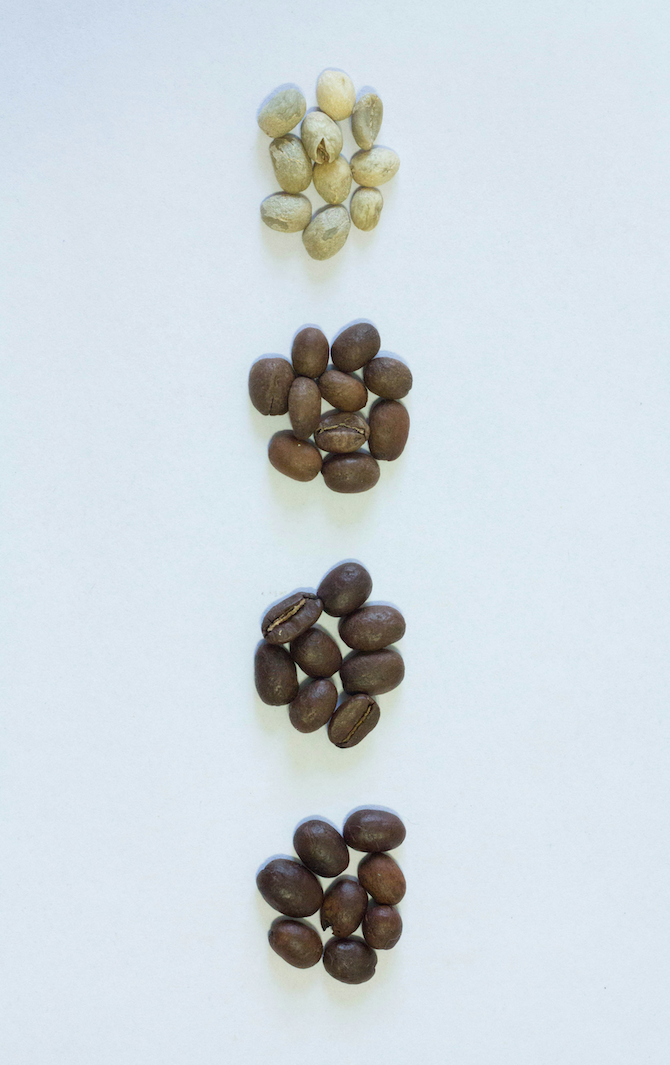Grating profiles
Coffee roasting is art and science in a wonderful combination. And you rarely hit the exact same result twice. There are many variables to decide on, and this is exactly what makes the craft fun – a combination of temperature, smell, color and sound helps to guide the roasting process to completion. And it all changes from bean to bean and season to season.
The origin, type and processing of the beans determine the basic taste, while the roast profile largely determines which notes and characteristics of the coffee are emphasized or suppressed. At the darkest roasts, the terroir of the beans is really irrelevant.


Know it inside out!
When roasting, the water contained in the green beans evaporates. The beans expand and you can hear a little pop when the steam is released, this is called a crack. When you reach the first crack, coffee can be brewed from the beans if you want a very light roast. It is also an option to shake to or past another crack. Here, the structure of the coffee beans has begun to collapse, and the result is a darker roast.
Our grating profiles
Below you can read a little more about the roasting profiles we work with at Fanø MikroRisteri. Note that other roasteries may use slightly different terms, have different definitions, etc. The transition between the individual profiles is also fluid and can always be discussed, for example over a good cup of coffee. Sometimes we therefore use a small plus symbol to mark that we are very close to a darker grid profile, e.g. Full city+.
We prefer to roast our coffees from American to Vienna, but it is therefore possible to roast both lighter and darker. So if you want to try a slightly more extreme grilling profile, we can easily make it happen, but with your own taste buds as an effort.
-
Cinnamon
Cinnamon is the first profile that can actually be drunk. It occurs right at the first crack. The coffee beans are very light brown and have only just begun to smell a little of what we normally associate with coffee. The nuances of taste are characterized by grass, hay and earth. The acidity of the beans is very marked and the experience will generally be very raw and vegetal.
-
New England
Here we have passed the first crack. The brown color is a little deeper and the acidity has gained more complexity. The completely raw nuances are gone, and the bean type's original notes of fruit and flowers are very clean. The mouthfeel is tea-like with a mild body, fresh acidity and clarity. The roast profile makes the most sense if you want the terroir of the bean to stand out completely unspoiled and is therefore primarily used for the very finest coffees.
-
American
Now the more chocolatey brown color is starting to emerge. We are some way past the first crack, and there is more sweetness, good body and sour notes. The original qualities of the bean are still very present, and it is easy to like the very balanced mouthfeel, which is completely clean - without smoke and burnt notes.
-
City
We have now reached the middle of the first crack. Here you can really start to see and smell the coffee's good and characteristic qualities, the body is balanced, and you can still sense a bit of acidity. Coffee with this roast profile is flavorful, but without tasting roasted, and the many delicate flavor nuances from the terroir of the beans are still evident. The coffee is fresh and you slowly begin to sense the sweetness of the caramelisation.
-
Full city
Here we are right on the threshold of the second crack. There may be spotty oil extractions on the beans, which have now taken on a deep brown hue. The mouthfeel is full and decadent. The taste of the coffee is strong and the original quality of the beans is less pronounced, the burnt notes begin to be perceived and the acid is suppressed.
-
Vienna
The color of the beans is now dark brown, we are past the second crack and there will be small oil extractions. The beans are bittersweet with subtle caramel, nutmeg and chocolate flavors as well as subdued acidity and a smoky aroma. There is now even less terroir, and the profile is often good for e.g. cappuccino and other milk drinks, as the bitter notes are thus balanced out by the fat and sweeteners from the milk.
-
French
The coffee beans are now shiny with oil and very dark brown. There is no acid and the bittersweetness is very marked. We are well past the second crack, and the original characteristics from the origin of the bean are almost completely gone. The burnt taste is so distinctive that it is difficult to determine which bean has been used.
-
Italian
Now the beans are almost completely black, we are well past the second crack and close to pure coal. The burnt tones have completely taken over and there is no acid left. The mouthfeel is heavy and all original notes have disappeared. The smoky flavor is a hellish mix of blackcurrants, cocoa powder and cloves.
